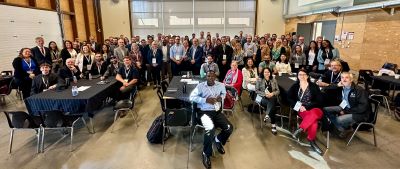The “best-kept-secret” in Canada’s innovation ecosystem is seeing increasing demand for its services
NOTE: See also accompanying story: “Want to incorporate AI into your business? Who you gonna call?”
They’ve been called the best-kept secret in Canada’s innovation ecosystem, but there has never been a greater demand for their services.
A growing number of small and medium-sized businesses are lining up to tap into the country’s network of 67 Technology Access Centres (TACs) – each of them affiliated with a publicly supported Canadian college, polytechnic or, in Quebec, a Cégep.
 “By design, TACs are set up to address the needs of small and medium-sized companies (SMEs) for R&D support,” Ken Doyle (photo at right), executive director of Tech-Access Canada, told Research Money. Tech-Access Canada, based in Ottawa, is the national, not-for-profit organization that supports the pan-Canadian network of TACs.
“By design, TACs are set up to address the needs of small and medium-sized companies (SMEs) for R&D support,” Ken Doyle (photo at right), executive director of Tech-Access Canada, told Research Money. Tech-Access Canada, based in Ottawa, is the national, not-for-profit organization that supports the pan-Canadian network of TACs.
TACs are designed to help companies that don’t have in-house R&D capacity, or that lack the financial and human resources to either conduct R&D or access the cutting-edge technologies and expertise that SMEs need to be innovative, Doyle said.
“Our TAC members are the foremost leaders in college applied research and assisting Canadian entrepreneurs in developing new innovative products and solutions, using technology,” he said.
TACs, whose core operations are funded by the Natural Sciences and Engineering Council of Canada (NSERC), are located from St. John’s Newfoundland to Victoria, B.C. to Inuvik in the Northwest Territories, all of them operating with the same business model.
Each TAC is a state-of-the-art applied research and innovation centre that provides value-added R&D and innovation services, such as developing new prototypes, scaling processes and solving unique business challenges. They also offer objective advice, provide customized training for industry to upgrade technical skills, and de-risk the financial investment of implementing new equipment and adopting emerging technologies.
Ninety-five percent of the Canadian population lives within 50 kilometres of a college campus, Doyle noted.
Collectively, he said, the 67 TACs offer Canadian companies nearly four million square feet of dedicated innovation and applied research space, including $477 million worth of state-of-the-art equipment and research facilities.
 Companies also can access the TACs’ network of more than 2,000 multidisciplinary experts (photo of some TAC team members at right) with in-depth industry experience in business innovation and applied R&D.
Companies also can access the TACs’ network of more than 2,000 multidisciplinary experts (photo of some TAC team members at right) with in-depth industry experience in business innovation and applied R&D.
In addition, TACs provide experiential learning opportunities for more than 2,000 college students every year from their host institutions and recent graduates from universities. They get to train on the latest technologies and equipment, participate in work opportunities on applied research projects with industry partners, and position themselves for potential employment with companies.
About 85 percent of the 6,000 companies that TACs work with each year are SMEs, which pay a fee-for-service to access the TACs’ services, Doyle said.
In addition, the TACs also work with more than 1,000 other clients and partners, such as universities, government laboratories, independent labs, large multinationals and others.
Doyle pointed out that a big attraction of the TACs for innovative companies is their policy on intellectual property. All IP, including that generated in TAC-supported projects, remains with each company to exploit.
That differs from the policy at most universities and government labs, which typically retain the IP generated from R&D projects they support.
“Because of the economic development mandate of the publicly supported colleges, we feel that the companies are best positioned to commercially exploit any idea that comes out of [their R&D],” Doyle said.
TACs are able to move with speed and flexibility
Other advantages the TACs offer is their flexibility and being able to move at the speed of business even though they’re operating within the bureaucracy of a public institution like a college.
For example, it typically takes about nine months for NSERC to turn around an application for an applied research and development grant. That length of time “is make or break for a small company that’s working in a global value chain,” Doyle said.
In contrast, the TACs, through their interactive business program, can approve a project in about 72 hours, and the average time from start to completion of a project is 51 days.
“The speed is what we do: short-term projects, moving at the speed of business and reducing that risk of innovation,” Doyle said.
Tech-Access Canada created the “Jump Ball” initiative where any innovator, entrepreneur, college professor, industrial advisor from Industrial Research and Assistance Program (IRAP), and others can go to the program website and share as much detail as they want about their innovation challenge.
A “rapid responder” at each of the TACs will get back to Tech-Access Canada within 24 hours on if and how they can help, along with a contact at the TAC.
Tech-Access Canada then compiles a list of seven or eight TACs with the potential to help and shares that with the person who made the initial contact on the Jump Ball website, so they can contact the most suitable TAC and start the collaboration.
Tech-Access Canada also launched a program in 2016 called Interactive Visits, with support from the National Research Council’s Industrial Research Assistance Program (NRC-IRAP).
The program offers 20 hours of collaboration between an IRAP-referred company and a TAC, to get a specific piece of R&D done, a prototype refined, regulatory guidance and other help – which could lead to further collaboration with a TAC.
“We’ve done about 3,000 of these over the years, and it has been very successful,” Doyle said.
Tech-Access Canada also has a program called Strategic Interactions to address a business problem or need that requires collaboration by a couple of TACs, he said. “Now we’re able to bring together two TACs and 55 hours to collaborate and solve that company’s challenge.”
By design, TACs don’t compete with services provided by the private sector. The TACs’ business model requires any project, innovative concept or business problem brought to a TAC to be a novel engagement rather than, for example, a routine service or testing that can be addressed by private sector resources.
“We’ll scope [the problem] and if we can help, we will. If we can’t, we’ll refer them to another actor in the innovation ecosystem that is best-placed to help them,” Doyle said.
Waiting list of companies wanting to work with TACs
NSERC on its website describes TACs as “specialized centres of expertise intended to provide timely innovation support to a college’s community organizations from the private, public, health care or not-for-profit sectors. TACs provide capabilities that serve their community organizations’ applied research and innovation needs.”
The TACs complement other instruments and organizations that support knowledge transfer, such as the National Research Council’s research facilities, NRC-IRAP and the Regional Development Agencies, NSERC said.
NSERC currently provides a total of $14.24 million a year to 60 TACs across Canada to support their core operations. For that investment, the TACs generate a total of about $65 million in revenue annually through their fee-for-service.
The TACs also work with companies in key strategic sectors for Canada, such as advanced manufacturing, agtech and cleantech.
“We get those small Canadian companies that we’ve heard are technology adoption adverse or R&D adverse to open their wallets and invest in applied innovation,” Doyle said.
TACs typically help companies that are in the Technology Readiness Level 4 to 8 space – the so-called “valley of death” of commercialization – to get them through that valley and on to commercialize their innovations.
Given the timely and much-needed support the TACs offer, however, the number of TACs is insufficient to meet the demand.
When federal support for college research started about 20 years ago, there were only 13 eligible institutions, Doyle noted. Now there are more than 120 colleges, polytechnics and Cégeps.
Quebec has been particularly supportive of its Cégeps and their affiliated TACs. Of the 60 active TACs countrywide, 32 are in Quebec and 35 are in the rest of Canada.
In fact, the idea for TACs started in Quebec in 2010, with companies that would hire Cégeps' graduates coming to the colleges for help in solving the companies’ problems.
Doyle said while the NSERC funding for the TACs’ core operations is crucial and appreciated, the TAC model is so successful the network of TACs could be expanded to up to 90 centres if more funding was available.
“We know there’s a tremendous amount of pent-up demand,” Doyle said. Tech-Access Canada’s survey a couple of months ago of TAC members revealed more than 550 companies on the waiting list for TAC’s services.
“And those are companies that have a scoped project with a TAC. They’re just waiting for a spot to open up on the TAC’s dance card,” Doyle said.
Tech-Access Canada’s Interactive Visits program collaboration with IRAP opened this year in April, and it has already spent its allocated funding for the year to meet the demand from companies wanting to participate, he said.
“Demand is up 94 percent from last year and 170 percent compared with three years ago. But there’s this bottleneck of available funds.”
The total amount of core operational funding NSERC provides to each TAC hasn’t changed since 2019, and the number of TACs hasn’t grown since then even though other programs in NSERC’s College and Community Innovation program have received increased investment, Doyle said.
Federally funded research ecosystem in need of reform
The lack of available research funds for colleges points to a broader problem in the federally funded research ecosystem, as noted by Colleges & Institutes Canada (CICan) in a submission in May to the Standing Committee on Science and Research.
In 2021-22, colleges served their communities by conducting more than 8,150 applied research projects, while receiving only 2.9 percent of all federal research funding granted in that year, according to the submission.
“Proposed reforms such as the creation of a capstone research funding organization and the new Advisory Council on Science and Innovation must explicitly recognize and reflect the vital work of college applied research in Canada’s innovation ecosystem in their mandate, structure, composition, priorities, governance and terms and conditions,” CICan’s submission said.
NSERC’s tri-agency College and Community Innovation (CCI) program has invested more than $118 million in college applied research in the 2023 fiscal year, including support for TACs, Valérie Levert-Gagnon, media and public affairs officer for NSERC, said in an email to Research Money.
Budget 2023 invested $108.6 million over three years in the CCI program to help more Canadian businesses access the expertise and research and development facilities they need, Levert-Gagnon said.
College stakeholders were consulted about the use of these funds, she said. Over the three-year Budget 2023 investment, combined annual expenditures on TAC grants is $23.4 million.
“TAC grants are just one part of the broader CCI program, which supports a range of other critical initiatives through a suite of five different funding streams,” Levert-Gagnon said.
“These funding streams are designed to be complementary and meet the diverse needs of the college applied research ecosystem, while achieving the overall aims of the CCI program and supporting government priorities,” she said.
However, to work with a TAC and take advantages of the benefits it offers, a company has to first start the collaboration with a TAC – and hundreds of companies are waiting in line to do just that.
Although the TACs currently work with 6,000 companies a year, Doyle said the TACs could easily work with 20,000 companies annually under the right conditions.
“Demand is not a problem. Companies want to innovate, they want to innovate in Canada. It’s just we’re capacity-constrained,” Doyle said.
Colleges no longer have to do any outreach to find companies for their TACs to collaborate with, he added. “Companies are banging down their doors. It guts them [the TACs] to have to turn companies away.”
Other countries in the Organisation for Economic Development and Co-operation are now inquiring about Canada’s TAC model and how it might be implemented in their countries, Doyle said. These countries are also struggling with the same problem as Canada: small companies that don’t innovate and aren’t able to do R&D.
“We’re one of the only countries on the planet that has a very strong community college sector,” Doyle said. “So being able to tap into those public investments and community college infrastructure to help the R&D challenges of the small companies that make up the majority of Canada’s industry is unique.”
R$
| Organizations: | |
| People: | |
| Topics: |
Events For Leaders in
Science, Tech, Innovation, and Policy
Discuss and learn from those in the know at our virtual and in-person events.
See Upcoming Events
You have 0 free articles remaining.
Don't miss out - start your free trial today.
Start your FREE trial Already a member? Log in
By using this website, you agree to our use of cookies. We use cookies to provide you with a great experience and to help our website run effectively in accordance with our Privacy Policy and Terms of Service.



.png)

